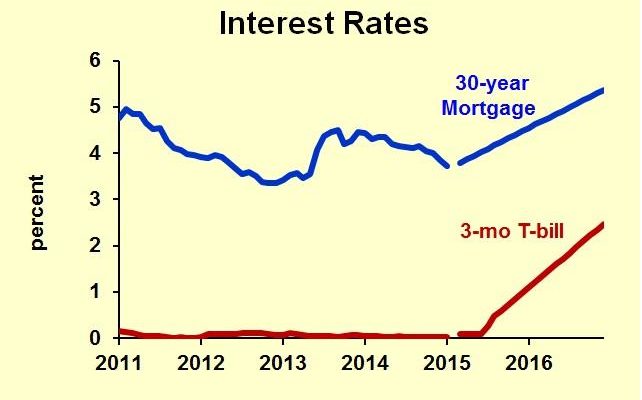Interest rates are headed up, but at a fairly mild pace. The Federal Reserve will start pushing short-term rates up this summer, probably in June. Long-term rates will rise also, thanks to global demand for credit rising faster than global savings.
The Fed’s upcoming tightening decision puzzles many people, because current inflation is very low. The Fed’s goal is for their favorite inflation gauge, the personal consumption price index excluding food and energy, to rise by two percent annually. It’s currently at 1.5 percent.
The key to the Fed’s thinking, though, is time lags. In crude terms, the time lag between Fed action and the real side of the economy (spending, employment and production) is about one year, and the further lag to price changes is another year. Thus, the Fed today is thinking about the prospects for inflation in 2017. The current rate of economic growth could well result in accelerating inflation two years from now, so the Fed will act soon.

There is no single economic indicator that drives the Fed’s thinking, but they are certainly aware of good results for gross domestic product, employment, industrial production, as well as the stimulus coming from lower oil prices.
The Fed probably will not feel the need to press down too hard on the brake pedal. When they are desperate, they move short-term interest rates by three percentage points in a year. More likely this cycle is an increase of 1.5 percentage points over a 12-month period, followed by a similar increase the following 12 months.
Statements by Federal Reserve officials emphasize that their plans are data dependent. That is, if the economy falters, then the rate hikes will be postponed. If the economy strengthens, the rate hikes could be sooner and more pronounced.
Long-term interest rates, such as mortgages and Treasury bonds, are driven more by worldwide financial forces, with smaller effects from Federal Reserve policy. The world economic outlook is for growth at about the recent pace. We had previously been expecting an acceleration, but disappointments in Europe and China have toned down that optimism. Still, the projections imply that global demand for credit will exceed global supply of savings, pushing interest rates up. The increase, though, will be fairly small. If the global economy accelerates, then look for a faster increase in long-term interest rates. Conversely, a global recession would push rates down.

